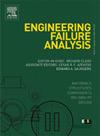Failure analysis and design improvement of a hot ironing die holder
IF 4.4
2区 工程技术
Q1 ENGINEERING, MECHANICAL
引用次数: 0
Abstract
Hot ironing is a hot metal forming process where a cup shaped workpiece was pushed through ring-shaped dies. The workpiece elongates as process goes while its wall thickness decreases. The rings are held by a holder piece which should be sized to have enough stiffness and load-bearing capacity. Also, the diametral stability and structural capacity of the rings are supported by die holder structure. Failure of a die holder was investigated on metallurgical and numerical basis. First, metallurgical tests were performed to evaluate hardness, chemical composition and microstructure. Then, detailed finite element models were created to observe general stress distribution in the part as well as identifying possible hot spots for failure initiation. During metallurgical examinations, the material was observed to contain carbides which induce brittle behavior. Additionally, the threaded holes used to assist in the disassembly of the rings cause significant stress concentration. After evaluation of both metallurgical and numerical studies, the failure that initiated from stress concentration around threaded hole was explained in detail. Furthermore, design was improved by removing threaded holes that cause stress concentration.
求助全文
约1分钟内获得全文
求助全文
来源期刊

Engineering Failure Analysis
工程技术-材料科学:表征与测试
CiteScore
7.70
自引率
20.00%
发文量
956
审稿时长
47 days
期刊介绍:
Engineering Failure Analysis publishes research papers describing the analysis of engineering failures and related studies.
Papers relating to the structure, properties and behaviour of engineering materials are encouraged, particularly those which also involve the detailed application of materials parameters to problems in engineering structures, components and design. In addition to the area of materials engineering, the interacting fields of mechanical, manufacturing, aeronautical, civil, chemical, corrosion and design engineering are considered relevant. Activity should be directed at analysing engineering failures and carrying out research to help reduce the incidences of failures and to extend the operating horizons of engineering materials.
Emphasis is placed on the mechanical properties of materials and their behaviour when influenced by structure, process and environment. Metallic, polymeric, ceramic and natural materials are all included and the application of these materials to real engineering situations should be emphasised. The use of a case-study based approach is also encouraged.
Engineering Failure Analysis provides essential reference material and critical feedback into the design process thereby contributing to the prevention of engineering failures in the future. All submissions will be subject to peer review from leading experts in the field.
 求助内容:
求助内容: 应助结果提醒方式:
应助结果提醒方式:


